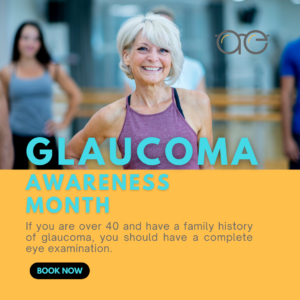Glaucoma Awareness Month
What is Glaucoma?
Glaucoma is a group of eye diseases that cause progressive damage to the optic nerve and are characterized by loss of nerve tissue, resulting in vision loss.
In most cases, glaucoma is associated with increased intraocular pressure (hypertension). If left untreated or uncontrolled, glaucoma can initially lead to loss of peripheral vision and eventually to blindness. According to the World Health Organization, glaucoma is the second leading cause of blindness worldwide (after cataracts).
Glaucoma Types and Causes
Types and causes of glaucoma There are many types of glaucoma, and there are many theories about the cause, but the exact cause is unknown. The two main types are open and acute closed. Characteristic of both types is a marked increase in intraocular pressure (pressure inside the eye). According to the American Academy of Ophthalmology (AAO), open-angle glaucoma affects about 2.2 million people in the United States and is expected to increase to 3.3 million by 2020 as the US population ages.
Glaucoma Risk Factors
The chronic form of glaucoma can damage vision before signs or symptoms appear, so be aware of the following risk factors:
- Increased internal intraocular pressure. Higher-than-normal internal intraocular pressure (IOP) increases the risk of developing glaucoma, but not all people with elevated intraocular pressure will develop glaucoma. age.
- People over 60 have an increased risk of this disease. People over 80 are 3 to 10 times more likely to develop glaucoma than people in their 40s. However, for African Americans, the increased risk begins after age 40.
- Race/Ethnicity. African Americans are far more likely to develop glaucoma than whites, and as a result, are far more likely to permanently lose their sight. Asians are at high risk of developing acute angle-closure glaucoma.
- Family history. Having a family history of glaucoma increases your risk of developing glaucoma. nick. Some studies suggest that diabetes can increase your risk of developing glaucoma, as can high blood pressure and heart disease.
- Eye injury. A serious injury to the eye immediately raises intraocular pressure, and internal damage can increase intraocular pressure in the future. Trauma can also lead to lens displacement, occlusion of the drainage angle, and increased pressure. Other eye-related hazards.
- The anatomy of the eye (i.e., the thickness of the cornea and the shape of the optic nerve) indicates the risk of developing glaucoma. Conditions such as retinal detachments, tumors, and inflammation of the eye can also cause glaucoma. Some studies suggest that a high degree of myopia may also be a risk factor for glaucoma.
- Use of corticosteroids. Long-term use of corticosteroids appears to put some people at risk of developing secondary glaucoma.
What are the warning signs?
Most people with glaucoma have no early symptoms or pain from high blood pressure, so it’s important to see your eye doctor regularly to diagnose and treat glaucoma before it causes long-term vision loss.
Glaucoma Treatment Options
There is no cure for glaucoma, but early diagnosis and ongoing treatment can protect your vision. Nerve damage and vision loss from glaucoma are usually irreversible. However, glaucoma can usually be controlled. Glaucoma treatment aims to lower intraocular pressure. The most common first-line treatment for glaucoma is usually prescription eye drops. In some cases, systemic medications, laser treatment, and/or other surgery may be required.
How can I reduce my risk of glaucoma?
In the context of glaucoma, risk reduction is a simple matter of damage control. There is little control over the development of glaucoma other than by following healthy lifestyle recommendations.
If you are over 40 and have a family history of glaucoma, you should have a complete eye examination by an optometrist every 1 to 2 years. You may need to see your eye doctor more often if you have health problems, such as diabetes or a family history of glaucoma, or if you are at risk for other eye conditions.
